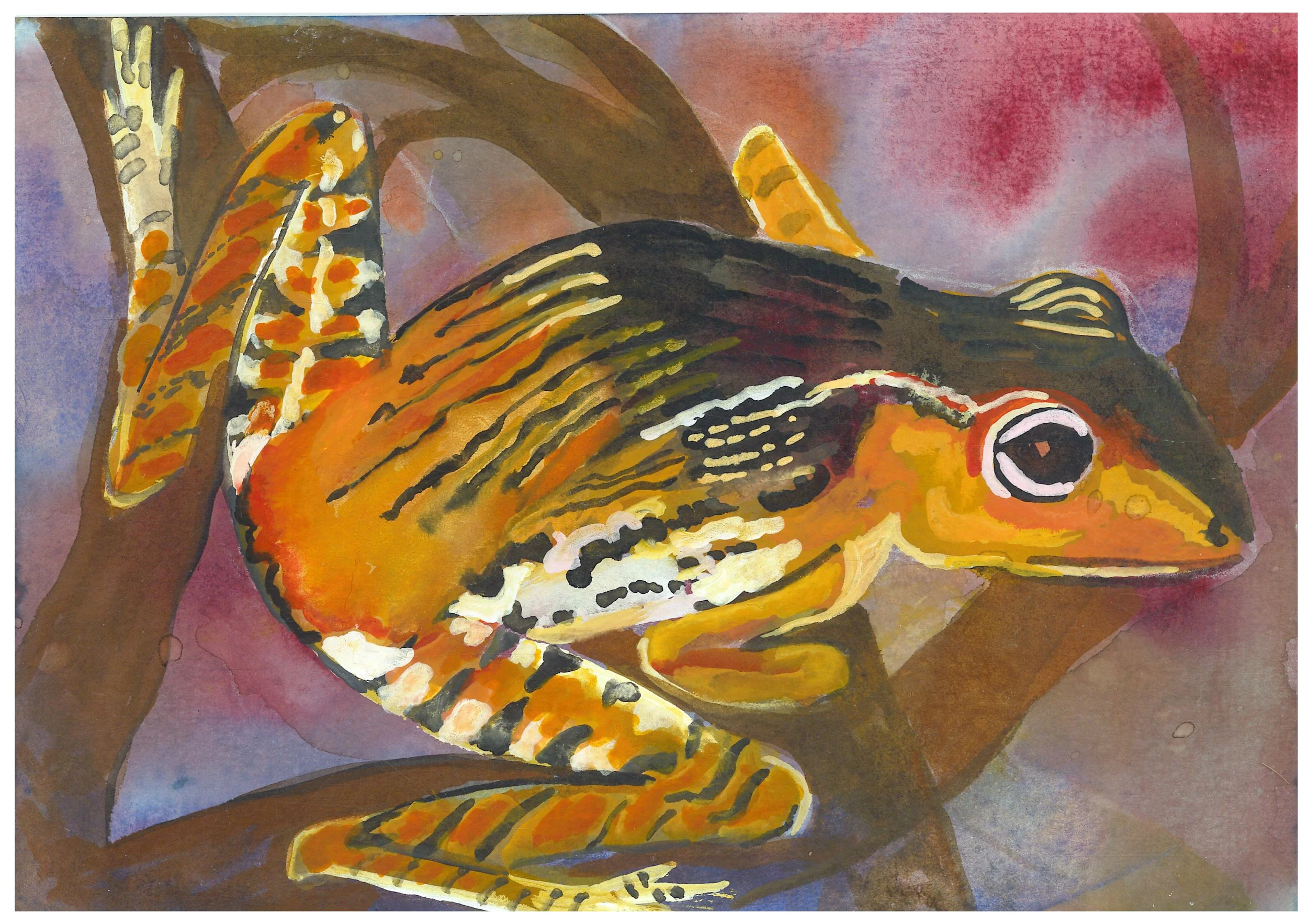Postcards from a Betrayed Island
Leatherback Turtle. Illustrated by Tansy Troy
The Great Nicobar Betrayal (2024) is essential reading for anyone concerned about India’s ecological future and the future of our species on Earth. Tansy Troy discusses the collection with an inspired set of illustrations of the island’s many breathtaking species.
Deeply informed by experts in multiple scientific, legal, ecological, and disaster study fields, The Great Nicobar Betrayal (Frontline 2024) is a series of thirteen essays meticulously curated by Pankaj Sekhsaria. Presenting a valid and watertight case for the Great Nicobar, the book is a defense of its pristine ecosystem, currently threatened by a £7 billion/₹8.1 billion crore project to transform the island into ‘the Hong Kong of India’.
The proposed construction of an international shipping terminal, airport, power plant, and military base has been met with grave concern amongst India’s scientific community, the Constitutional Conduct Group, and academics from around the world. In spite of a letter to the Indian president citing Article 338 of the Constitution (the article which safeguards scheduled tribes, to which the Forest (Conservation) Act of 1980 and Environment Protection Act of 1986 are supposed to be ‘subordinate’) as well as the Conference of Parties for the Convention of Biological Diversity’s agreement to “halt and reverse biodiversity loss” (December 2022), there has been no decision to change or amend plans for the Great Nicobar project to date.
Writing in The Guardian newspaper last year, Amrit Dhillon, quotes from another letter in which 39 scholars from 13 countries warned that “if the project goes ahead, even in a limited form, we believe it will be a death sentence for the Shompen (indigenous tribal peoples of Great Nicobar), tantamount to the international crime of genocide.” This is a critical moment in the history of indigenous peoples—a moment in history when land-grab seems to be the de facto norm across the globe—and could, perhaps, turn the tide for the greater good if defenders of the law raise their efforts to aid tribal peoples wherever land crises occur. Similarly, now that Animal Rights lawyers are fighting to identify whales and other animals as legal beings, this is a pivotal time for the many species of Great Nicobar in need of legal protection.
False Killer Whale. Illustrated by Tansy Troy
By giving voice to the voiceless multispecies, the contributing writers of The Great Nicobar Betrayal present their own compelling evidence not simply to highlight the importance of multispecies interdependence and need for this vibrant biodiversity to continue, but also to remind the powers that be of the legalities involved here. India’s threatened and endangered species are protected both by Indian law and by the UN General Assembly, whose declaration India signed (and continues to be bound by) in 2009.
“To the mainlander’s imagination, the islands might represent exotic unknown locations for exploration,” writes B. Chaudhuri in “Degrees of Insularity”, the fifth essay in the book. However, “to the indigenous peoples, each island is a microcosm of knowledge, stories, myths and cultural nuances.”
Presenting a valid and watertight case for the Great Nicobar, the book is a defense of its pristine ecosystem, currently threatened by a £7 billion/₹8.1 billion crore project to transform the island into ‘the Hong Kong of India’.
Sakhsaria himself compares this discrepancy between the mainlander imagination and the reality of life on Great Nicobar to the plight of one of the world’s rarest birds, the Nicobar Megapode, endemic to the islands. In his book Islands in Flux, quoted by Radhika Raj in her brilliant essay “In Search of the Last Megapodes”, (India’s Rarest Birds, Juggernaut 2024), he describes how both the Megapode and Great Nicobar itself “exist on the margins of human imagination – ignored and dispensable.”
Ajay Saini, in his piece “Whose Land is it?” explores the cosmology of the Nicobarese, the other indigenous tribe besides the Shompen, of Great Nicobar. “All living and non living entities,” he writes, “are part of a single, spiritual, moral and regenerative system. Death, in their worldview, is the perpetuation of life in a different form. But separation from the land is an irreparable loss” (emphasis mine).
The contributors to the collection argue that we still have much to learn from Great Nicobar, and a project involving major deforestation and mass imported infrastructure would rule out our greater understanding of life on earth and in ocean itself, impeding our future evolution as a species.
“Given its remote and relatively undisturbed status, this island has always had the potential of revealing a lot more to us,” writes Mahi Mankeshwar (“Life Around a Submerged Mountain”).“There were and still are, many ecological phenomena to unpack here,” agrees S. Harikrishna (“Sambelong Memories”).The forests of Great Nicobar, continues Saini, are “some of the least explored or studied in the world.” Should the plan for a mega port, the felling of up to 9 million trees, the “re-development” of the cleared land be permitted to proceed, “the true magnitude of this loss cannot be measured.”
In a sinister declaration of “protection” for the few hundred remaining members of the Shompen tribe who live deep in the island’s interior, the National Green Tribunal’s 64-page document states in its conditions for Environmental Clearance that the project activities shall not disturb the Shompen tribe and their habitations. In almost the next sentence, the document audaciously states that for their protection (and this is protection for a tribe who have presumably been able to protect themselves perfectly adequately since humankind evolved), “a surveillance mechanism shall be installed… near the tribal settlements.” (“The Flawed Judgement”, Norma Alvares).
Such haute surveillance tactics, along with the concrete bunker ‘camps’ in which the Nicobarese were rehabilitated after the 2004 tsunami destroyed their shoreline settlements, are reminiscent of the camps built by the Bostwanan government to compensate the Kalahari San Bushmen for being systematically evicted from their ancestral lands post 1995 to allow diamond companies the license to explore and excavate in the Kalahari Game Reserve. The San, now forbidden to hunt their original territory, have since dwindled in population and suffered the torments of a life removed from their inherited earth; similarly, it is reported that the Nicobarese, resettled in camps on the northern shore of Great Nicobar, are also prey to alcoholism, depression and suicide.
As the great wilderness writer Narendra declares in Landscapes of Wilderness, “land itself is a religion. That is where beliefs, values and gods came from.” In Saini’s piece, a tribal elder confided to the author, “We miss our villages, but they too miss us.” According to Sambelong philosophy, the earth beneath our feet, the Earth itself, has sentience, prescience, and is so deeply connected to those who live upon it that we cannot—as a species—be healthy or happy if our ancestral lands are not so.
Great Nicobar is home and nesting ground to the endangered Leatherback turtles, whose formerly UNESCO-protected beaches are crucial to their annual hatching cycle. The endangered and endemic Nicobar Megapodes, Nicobar Cricket Frogs, Nicobar Imperial Pigeons, Nicobar Serpent Eagles, Nicobar Treeshrews, Nicobar scops Owl, Nicobar Cat Snakes, Daniel’s Forest Lizards, Saltwater Crocodiles, Omura’s Whales, and False Killer Whales are amongst the other 1,767 (yes, you read that figure correctly) marine and terrestrial creatures that inhabit an island with a land mass of only 921 square kilometers.
Between 2017-2019 alone, 39 previously undiscovered species of flora and fauna were recorded on research trips to Great Nicobar. The geneses of its giant trees date back to the Pleistocene (the last Ice Age) period between 2.58 million- 11,700 years ago, the latter part of which, incidentally, was arguably the most intense evolutionary period for our very own species.
Along with the plan to destroy the terrestrial home of animals, birds and trees, marine life, and 4,000 immaculate coral reefs only just recovered from the 2004 tsunami are on the project hit-list. The plan to sever and ‘replant’ a percentage of these is considered to be highly dubious.
Nicobar Treeshrew. Illustrated by Tansy Troy
Despite the many ghastly scenarios outlined in the book, The Great Nicobar Betrayal hints at some fragile hope: in 2018, Uttarakhand High Court declared that the “entire animal kingdom including avian and aquatic beings” as legal beings. In 2020, Madras High Court went further: “Mother Nature”, it declared, is a “living being” and therefore may be defended as such (Shrishtee Bajpai, “Should Turtles go to Court?”). We have in our relatively recent legal history the success of the Save Silent Valley movement (1984), in which the Congress/United Democratic Front government of the time abandoned a major state hydroelectric project in Kerela thanks to public protest and grassroots environmental activism.
As the Great Nicobar case continues to hit the headlines and front covers of national media publications through 2025, a little birdie (possibly the endangered Great Nicobar Serpent Eagle, smallest eagle in the world) whispers that Sekhsaria is curating a second volume of essays to keep readers up to date with the latest developments in this critical case.
It would be laudable if our High Court judges, Indian government officials, and even erstwhile investors made a collective decision to protect, rather than destroy. To observe, rather than turn a blind eye. To honour, rather than to desecrate this rare jewel of an island, which stands at the extremity of India’s still abundant lands.
A couple of years ago, I interviewed members of the Amche Mollem movement in Goa, launched in 2020 to halt three major infrastructure projects which aimed to deeply disrupt pristine and undisturbed National Park Forest. I was enthused by the degree of public support that the movement received. In this case, hard-hitting citizen protest through art, word and legal injunctions turned the tide on many eco-destructive plans. Trisha Dias Sabir, a founding member the movement recalls how she was prompted to action after reading Nandini Velho’s article, where she discovered that “…infrastructure would forever change the 150-million-year-old-landscape… it felt only natural to want to turn the project around.”
Does The Great Nicobar Betrayal encourages citizen action, too? In my own case, reading these essays prompts me to paint a series of “Postcards from a Betrayed Island”, watercolours of the endangered species I discover through the course of the text. My original aim is to reproduce these and send them to as many government ministers as I can find addresses for (though friends tell me this would be a “waste of a good postcard”). I’m motivated by the idea of sharing images of the many beautiful creatures from the Nicobar, as if the act of painting and sharing constitutes an act of protest in itself.
I fall to thinking how incredible it would be if, inspired by words and images of the island’s current state of complex multispecies diversity, the entirety of Great Nicobar could become a protected zone of extreme scientific interest. It would be laudable if our High Court judges, Indian government officials, and even erstwhile investors made a collective decision to protect, rather than destroy. To observe, rather than turn a blind eye. To honour, rather than to desecrate this rare jewel of an island, which stands at the extremity of India’s still abundant lands.
Saltwater Crocodile. Illustrated by Tansy Troy
Nicobar Cat Snake. Illustrated by Tansy Troy
Nicobar Tree Frog. Illustrated by Tansy Troy
Daniel’s Forest Lizard. Illustrated by Tansy Troy
Nicobar Parakeet. Illustrated by Tansy Troy
Nicobar Scops Owl. Illustrated by Tansy Troy
Dwarf Kingfishers. Illustrated by Tansy Troy
Red Whiskered Bulbuls. Illustrated by Tansy Troy
Nicobar Civet Cat. Illustrated by Tansy Troy
Omura’s Whale. Illustrated by Tansy Troy
***
Tansy Troy is an India-based educationalist, poet, performer, playwright and maker of bird and animal masks. She conceived and edits The Apple Press, a young people’s eco journal which features poetry, stories, articles and artwork. Tansy has published poetry, articles and reviews in The Hindustan Times, The Hindu, The Scroll, Punch Magazine, Art Amour, Muse India, Plato’s Cave and The Yearbook of Indian Poetry in English. Join her on the journey @voice_of_the_turtle and @the_adventures_of_tara.














